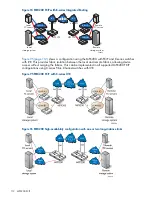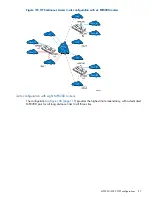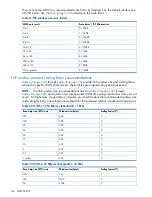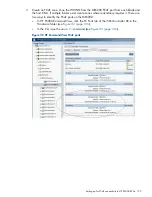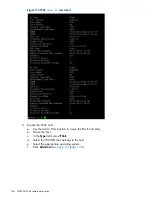
•
TCP window size/ scaling performance tuning
•
Modifying the window size and scaling factor
•
TCP window size and scaling factor recommendations
Distance
Consider the physical distance between the MPX200 Multifunction Routers. This is usually measured
in RTT. The RTT can be anywhere from less than 1 millisecond to as great as 200 milliseconds.
Bandwidth per route
Bandwidth is a measure of the volume of data that can be transmitted at a given transmission rate.
WAN data rates typically range from 1.5 Mb/s (T1) to 1 Gb/s. The proper MPX200 bandwidth
setting is determined based on the bandwidth that is available for each FCIP route, irrespective of
the total bandwidth and physical speed of the link.
To determine the proper MPX200 bandwidth setting, start with the total bandwidth of the WAN
link. Adjust this number based on the guaranteed allocated FCIP bandwidth and further adjust this
number if the number of FCIP routes configured is greater than one. For example, if the WAN link
is 45 Mb/s and 15 Mb/s is allocated to network traffic, the remaining 30 Mb/s is available for
FCIP. If in this example the MPX200 is configured for two routes, based on the 30 Mb/s total
bandwidth available for FCIP, you would set the MPX200 bandwidth parameter to 15, the available
bandwidth for each FCIP route.
HP Continuous Access replication solution requires dedicated bandwidth for the intersite link. If
other applications share the intersite link, some method of QOS must be used to ensure that the
replication application has uncontested access to the allocated bandwidth.
NOTE:
Setting the bandwidth per route setting higher than the actual bandwidth available for
each route results in a decrease in performance; the optimal setting matches the bandwidth per
route setting to the actual bandwidth available for each route.
Latency
Latency is the amount of time a packet takes to traverse the network from source to destination.
MTU/Jumbo frames
•
For MTU size there are 3 choices,
normal
(1500 bytes),
Jumbo
(9000 bytes) and
other
, where
you are then prompted for a value between 1000 and 9000.
•
Typically MTU should be set to the default of 1500; rarely do WAN networks support MTU
sizes greater than 1500. An MTU setting that is too high can result in a high number of
dropped packets and retransmissions, significantly impacting performance. An MTU that is
too low (less than 1200) causes a single Fibre Channel frame to be spread across more than
two Ethernet frames, also impacting performance. Using an MTU size of 1500 to 1200 ensures
a single Fibre Channel frame (2112 bytes) fits within two Ethernet frames, resulting in optimal
performance.
•
Encryption products on the WAN link often add some number of additional bytes to each
packet, so it may be necessary to decrease the MPX200 MTU size setting to between 1450
and 1200. This reduction accommodates the additional bytes, while maintaining a total MTU
size of 1500 or less.
•
Jumbo frames can enhance the IP performance of the MPX200. Before enabling Jumbo frames
however, you must ensure that the entire network is enabled for Jumbo frames. If any
122
MPX200 FCIP





